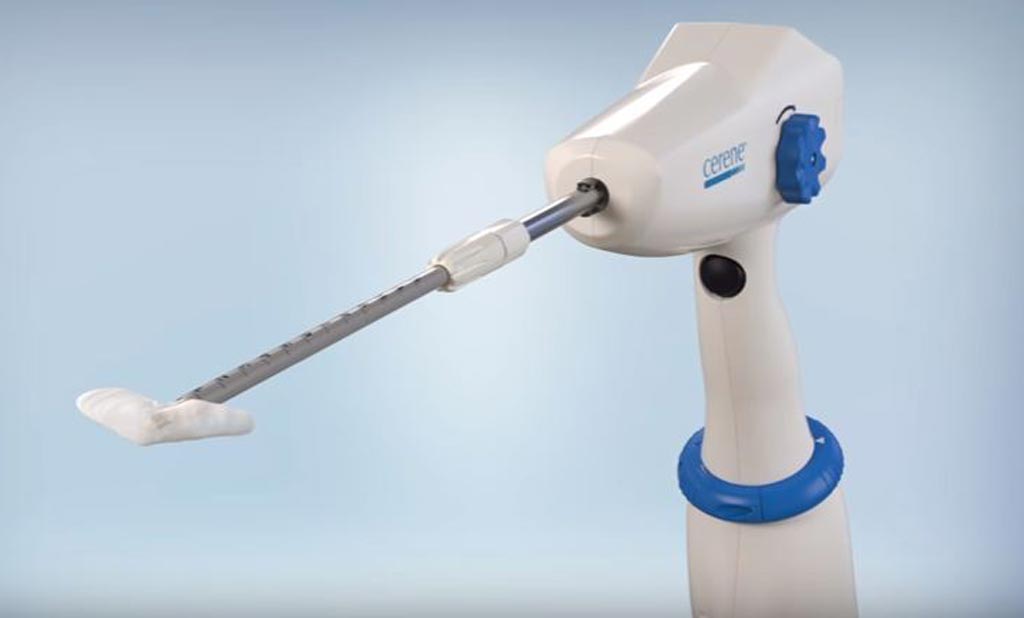Cryotherapy Device Treats Heavy Menstrual Bleeding
|
By HospiMedica International staff writers Posted on 16 Apr 2019 |

Image: The Cerene cryotherapy device is designed to reduce menstrual bleeding (Photo courtesy of Channel Medsystems).
A novel nitrous oxide (N2O) cryotherapy device freezes the lining of the uterus in order to significantly reduce future menstrual bleeding.
The Channel Medsystems (Emeryville, CA, USA) Cerene cryotherapy device is indicated for endometrial cryoablation in premenopausal women with heavy menstrual bleeding due to benign causes, and for whom child bearing is complete. The cryothermic energy is provided by a liquid-to-gas phase change of N2O; during the 2½ minute treatment cycle, liquid N2O delivered from a small cylinder located in the device handle flows through a delivery line and into an inflow line with multiple jets. The liquid N2O is infused into an ultra-thin polyurethane liner, where it converts into gas and is exhausted from the bottom of the handle.
An exhaust collection bag transfers the gas to the conformable liner that enables close coverage of the irregular surfaces of the uterine cavity and provides an effective thermal transfer. Prior to cryotherapy delivery, the liner is inserted into the uterine cavity to the appropriate length--between 2.5 and 6.5 cm, based upon prior uterine sound measurements--inside a thermally insulating sheath. Once in position, the user rotates a knob to retract the insulating sheath; the retraction also controls the number of eventual N2O jets exposed within the liner.
The liner is gradually pressurized with filtered air, deflated, and re-pressurized a second time. Once a final leak detection test is completed, N2O flow is automatically initiated. After 2½ minutes, N2O flow is stopped and the user is prompted to rotate a twist ring to vent the remaining gas. The uterine cavity is allowed to thaw, and vacuum is initiated within the liner to expedite device removal. After use, the entire device and the exhaust collection bag are disposed of. Sequential operating instructions and device status are continuously displayed on the device’s LCD Screen.
“The Cerene Device provides gynecologists with the first realistic option for treatment in their office, a setting that is more comfortable for women and significantly less expensive for the healthcare system,” said Ric Cote, President and CEO of Channel Medsystems. “The shift away from the operating room that the Cerene Device enables could potentially reduce the cost to treat heavy menstrual bleeding by hundreds of millions of dollars annually.”
“Women who suffer from heavy menstrual bleeding are seeking safe and effective treatments that are well tolerated with minimal inconvenience. Channel Medsystems has developed a treatment that is easy to use, is reproducible in any setting of care, and is very well tolerated without anesthesia,” said Ted Anderson, MD, PhD, of Vanderbilt University Medical Center. “The development of new technology like the Cerene Device could allow gynecologists to provide a safe, effective, affordable, and convenient treatment to the millions of women who seek care for heavy menstrual bleeding.”
Cryoablation, the use of extreme cold to destroy tissue, is a well-characterized, durable therapy routinely used to ablate malignant and benign cardiac, liver, breast, and prostate tissue, among others. In the uterus, the use of cryothermic energy has been shown to reduce the likelihood of scarring and intrauterine adhesions that are often associated with heat-based treatments, which may contribute to the development of long-term complications, including re-operation and, ultimately, the failure of endometrial ablation.
Related Links:
Channel Medsystems
The Channel Medsystems (Emeryville, CA, USA) Cerene cryotherapy device is indicated for endometrial cryoablation in premenopausal women with heavy menstrual bleeding due to benign causes, and for whom child bearing is complete. The cryothermic energy is provided by a liquid-to-gas phase change of N2O; during the 2½ minute treatment cycle, liquid N2O delivered from a small cylinder located in the device handle flows through a delivery line and into an inflow line with multiple jets. The liquid N2O is infused into an ultra-thin polyurethane liner, where it converts into gas and is exhausted from the bottom of the handle.
An exhaust collection bag transfers the gas to the conformable liner that enables close coverage of the irregular surfaces of the uterine cavity and provides an effective thermal transfer. Prior to cryotherapy delivery, the liner is inserted into the uterine cavity to the appropriate length--between 2.5 and 6.5 cm, based upon prior uterine sound measurements--inside a thermally insulating sheath. Once in position, the user rotates a knob to retract the insulating sheath; the retraction also controls the number of eventual N2O jets exposed within the liner.
The liner is gradually pressurized with filtered air, deflated, and re-pressurized a second time. Once a final leak detection test is completed, N2O flow is automatically initiated. After 2½ minutes, N2O flow is stopped and the user is prompted to rotate a twist ring to vent the remaining gas. The uterine cavity is allowed to thaw, and vacuum is initiated within the liner to expedite device removal. After use, the entire device and the exhaust collection bag are disposed of. Sequential operating instructions and device status are continuously displayed on the device’s LCD Screen.
“The Cerene Device provides gynecologists with the first realistic option for treatment in their office, a setting that is more comfortable for women and significantly less expensive for the healthcare system,” said Ric Cote, President and CEO of Channel Medsystems. “The shift away from the operating room that the Cerene Device enables could potentially reduce the cost to treat heavy menstrual bleeding by hundreds of millions of dollars annually.”
“Women who suffer from heavy menstrual bleeding are seeking safe and effective treatments that are well tolerated with minimal inconvenience. Channel Medsystems has developed a treatment that is easy to use, is reproducible in any setting of care, and is very well tolerated without anesthesia,” said Ted Anderson, MD, PhD, of Vanderbilt University Medical Center. “The development of new technology like the Cerene Device could allow gynecologists to provide a safe, effective, affordable, and convenient treatment to the millions of women who seek care for heavy menstrual bleeding.”
Cryoablation, the use of extreme cold to destroy tissue, is a well-characterized, durable therapy routinely used to ablate malignant and benign cardiac, liver, breast, and prostate tissue, among others. In the uterus, the use of cryothermic energy has been shown to reduce the likelihood of scarring and intrauterine adhesions that are often associated with heat-based treatments, which may contribute to the development of long-term complications, including re-operation and, ultimately, the failure of endometrial ablation.
Related Links:
Channel Medsystems
Latest Surgical Techniques News
- Major Study Examines Endoscopies that Fail to Detect Esophageal Cancer
- Robotic Assistant Delivers Ultra-Precision Injections with Rapid Setup Times
- Minimally Invasive Endoscopic Surgery Improves Severe Stroke Outcomes
- Novel Glue Prevents Complications After Breast Cancer Surgery
- Breakthrough Brain Implant Enables Safer and More Precise Drug Delivery
- Bioadhesive Sponge Stops Uncontrolled Internal Bleeding During Surgery
- Revolutionary Nano Bone Material to Accelerate Surgery and Healing
- Superior Orthopedic Implants Combat Infections and Quicken Healing After Surgery
- Laser-Based Technique Eliminates Pancreatic Tumors While Protecting Healthy Tissue
- Surgical Treatment of Severe Carotid Artery Stenosis Benefits Blood-Brain Barrier
- Revolutionary Reusable Duodenoscope Introduces 68-Minute Sterilization
- World's First Transcatheter Smart Implant Monitors and Treats Congestion in Heart Failure
- Hybrid Endoscope Marks Breakthrough in Surgical Visualization
- Robot-Assisted Bronchoscope Diagnoses Tiniest and Hardest to Reach Lung Tumors
- Diamond-Titanium Device Paves Way for Smart Implants that Warn of Disease Progression
- 3D Printable Bio-Active Glass Could Serve as Bone Replacement Material
Channels
Critical Care
view channel
CPR Guidelines Updated for Pediatric and Neonatal Emergency Care and Resuscitation
Cardiac arrest in infants and children remains a leading cause of pediatric emergencies, with more than 7,000 out-of-hospital and 20,000 in-hospital cardiac arrests occurring annually in the United States.... Read more
Ingestible Capsule Monitors Intestinal Inflammation
Acute mesenteric ischemia—a life-threatening condition caused by blocked blood flow to the intestines—remains difficult to diagnose early because its symptoms often mimic common digestive problems.... Read more
Wireless Implantable Sensor Enables Continuous Endoleak Monitoring
Endovascular aneurysm repair (EVAR) is a life-saving, minimally invasive treatment for abdominal aortic aneurysms—balloon-like bulges in the aorta that can rupture with fatal consequences.... Read more
Wearable Patch for Early Skin Cancer Detection to Reduce Unnecessary Biopsies
Skin cancer remains one of the most dangerous and common cancers worldwide, with early detection crucial for improving survival rates. Traditional diagnostic methods—visual inspections, imaging, and biopsies—can... Read morePatient Care
view channel
Revolutionary Automatic IV-Line Flushing Device to Enhance Infusion Care
More than 80% of in-hospital patients receive intravenous (IV) therapy. Every dose of IV medicine delivered in a small volume (<250 mL) infusion bag should be followed by subsequent flushing to ensure... Read more
VR Training Tool Combats Contamination of Portable Medical Equipment
Healthcare-associated infections (HAIs) impact one in every 31 patients, cause nearly 100,000 deaths each year, and cost USD 28.4 billion in direct medical expenses. Notably, up to 75% of these infections... Read more
Portable Biosensor Platform to Reduce Hospital-Acquired Infections
Approximately 4 million patients in the European Union acquire healthcare-associated infections (HAIs) or nosocomial infections each year, with around 37,000 deaths directly resulting from these infections,... Read moreFirst-Of-Its-Kind Portable Germicidal Light Technology Disinfects High-Touch Clinical Surfaces in Seconds
Reducing healthcare-acquired infections (HAIs) remains a pressing issue within global healthcare systems. In the United States alone, 1.7 million patients contract HAIs annually, leading to approximately... Read moreHealth IT
view channel
Printable Molecule-Selective Nanoparticles Enable Mass Production of Wearable Biosensors
The future of medicine is likely to focus on the personalization of healthcare—understanding exactly what an individual requires and delivering the appropriate combination of nutrients, metabolites, and... Read moreBusiness
view channel
Philips and Masimo Partner to Advance Patient Monitoring Measurement Technologies
Royal Philips (Amsterdam, Netherlands) and Masimo (Irvine, California, USA) have renewed their multi-year strategic collaboration, combining Philips’ expertise in patient monitoring with Masimo’s noninvasive... Read more
B. Braun Acquires Digital Microsurgery Company True Digital Surgery
The high-end microsurgery market in neurosurgery, spine, and ENT is undergoing a significant transformation. Traditional analog microscopes are giving way to digital exoscopes, which provide improved visualization,... Read more
CMEF 2025 to Promote Holistic and High-Quality Development of Medical and Health Industry
The 92nd China International Medical Equipment Fair (CMEF 2025) Autumn Exhibition is scheduled to be held from September 26 to 29 at the China Import and Export Fair Complex (Canton Fair Complex) in Guangzhou.... Read more












